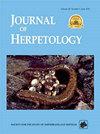Trophic Ecology of African Dwarf Crocodiles (Osteolaemus spp.) in Perennial and Ephemeral Aquatic Habitats
IF 0.8
4区 生物学
Q3 ZOOLOGY
引用次数: 0
Abstract
Abstract. Crocodilians occupy diverse aquatic and riparian habitats, and through their movements and ontogenetic niche shifts, link the flow of energy and nutrients between aquatic and terrestrial food webs. We analyzed the trophic ecology of African dwarf crocodiles Osteolaemus tetraspis and O. osborni at one site for each species in Cameroon by analyzing carbon and nitrogen stable isotope ratios. We hypothesized that Osteolaemus species inhabiting a perennial river would be primarily associated with aquatic food webs, whereas those inhabiting a small ephemeral stream would assimilate significant fractions of terrestrial-derived material into their biomass. We also hypothesized that Osteolaemus species would undergo ontogenetic trophic shifts, including changes in vertical trophic position (TP). We found that crocodiles in both systems assimilated material from both terrestrial and aquatic-based food chains, and therefore provide a trophic link between habitats. In the perennial river, aquatic gastropods, fish, and amphibians were estimated to have higher maximum feasible contributions to crocodile biomass than terrestrial invertebrates. Prey contributions to crocodile biomass in the ephemeral stream could not be estimated because model results suggested that at least one important prey had not been sampled. Even though isotopic overlap was high between juveniles and adults, and between sexes, ontogenetic shifts in TP were apparent in both Osteolaemus populations.非洲矮鳄(Osteolaemus spp.)在多年生和短命水生栖息地的营养生态学
摘要鳄鱼占据着不同的水生和河岸栖息地,通过它们的运动和个体发生的生态位变化,将水生和陆地食物网之间的能量和营养流动联系起来。利用碳、氮稳定同位素比值分析了喀麦隆四aspis和O. osborni两种非洲矮鳄的营养生态学特征。我们假设居住在多年生河流中的骨螈物种主要与水生食物网有关,而居住在短暂河流中的骨螈物种则会将大量陆源物质吸收到它们的生物量中。我们还假设骨螈物种会经历个体发生的营养转移,包括垂直营养位置(TP)的变化。我们发现这两个系统中的鳄鱼都吸收了陆地和水生食物链中的物质,因此在栖息地之间提供了营养联系。在多年生河流中,水生腹足类动物、鱼类和两栖动物对鳄鱼生物量的最大可行贡献估计高于陆生无脊椎动物。由于模型结果表明,至少有一种重要的猎物没有被采样,因此无法估计猎物对短暂溪流中鳄鱼生物量的贡献。尽管在幼鱼和成鱼之间以及两性之间的同位素重叠程度很高,但在两种骨螈种群中,TP的个体发生变化都很明显。
本文章由计算机程序翻译,如有差异,请以英文原文为准。
求助全文
约1分钟内获得全文
求助全文
来源期刊

Journal of Herpetology
生物-动物学
CiteScore
1.60
自引率
0.00%
发文量
45
审稿时长
6 months
期刊介绍:
The Journal of Herpetology accepts manuscripts on all aspects on the biology of amphibians and reptiles including their behavior, conservation, ecology, morphology, physiology, and systematics, as well as herpetological education. We encourage authors to submit manuscripts that are data-driven and rigorous tests of hypotheses, or provide thorough descriptions of novel taxa (living or fossil). Topics may address theoretical issues in a thoughtful, quantitative way. Reviews and policy papers that provide new insight on the herpetological sciences are also welcome, but they must be more than simple literature reviews. These papers must have a central focus that propose a new argument for understanding a concept or a new approach for answering a question or solving a problem. Focus sections that combine papers on related topics are normally determined by the Editors. Publication in the Long-Term Perspectives section is by invitation only. Papers on captive breeding, new techniques or sampling methods, anecdotal or isolated natural history observations, geographic range extensions, and essays should be submitted to our sister journal, Herpetological Review.
 求助内容:
求助内容: 应助结果提醒方式:
应助结果提醒方式:


